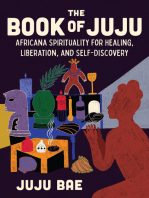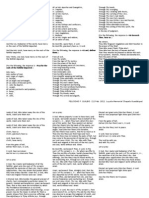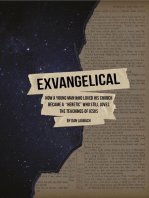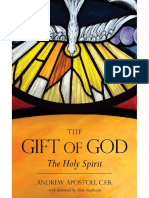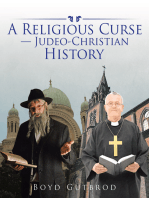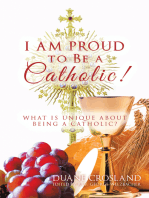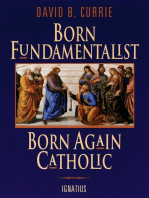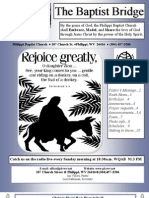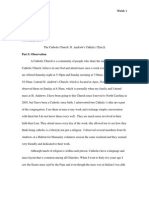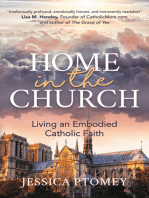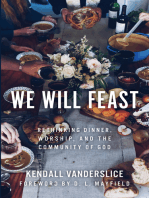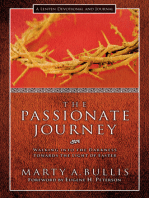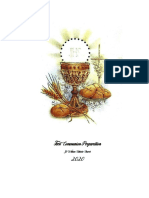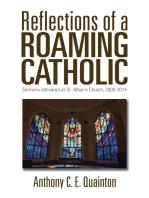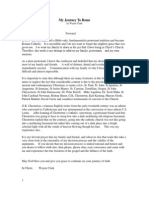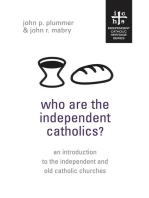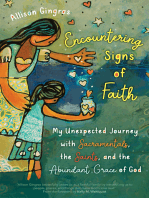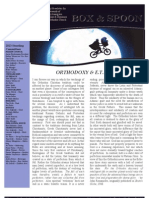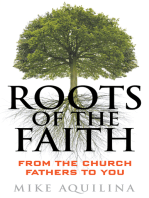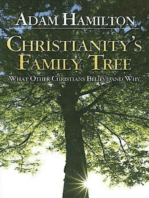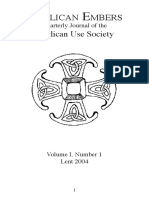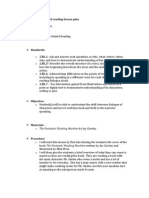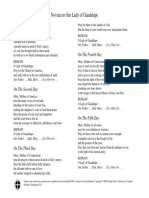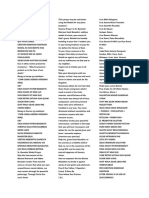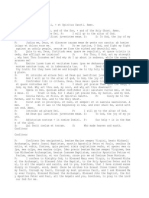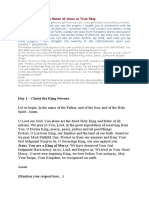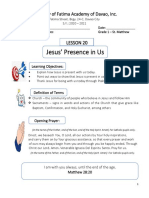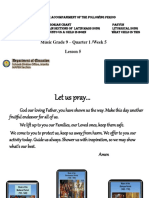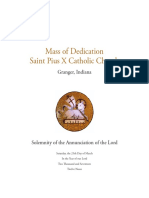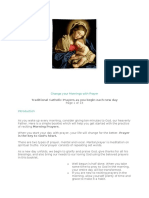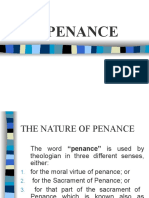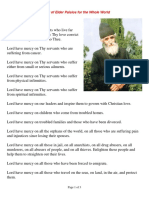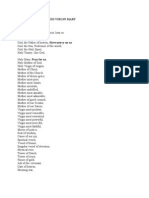My First Holy Communion and Confirmation
My First Holy Communion and Confirmation
Uploaded by
engoj35Copyright:
Available Formats
My First Holy Communion and Confirmation
My First Holy Communion and Confirmation
Uploaded by
engoj35Original Description:
Original Title
Copyright
Available Formats
Share this document
Did you find this document useful?
Is this content inappropriate?
Copyright:
Available Formats
My First Holy Communion and Confirmation
My First Holy Communion and Confirmation
Uploaded by
engoj35Copyright:
Available Formats
My First Holy Communion And Confirmation
The history of Communion and Confirmation in the Catholic Church
Jennifer Engo
Table of Contents
Introduction to my family and culture pages 3-4. History of Communion and Confirmation pages 5-6. My Communion page 7. My Confirmation page 8. Glossary page 9. Standards page 10. References page 11.
Introduction to my culture and family
Welcome to my family! We are a small but close family. In the picture above is my grandma Gangan, myself, my brother Jim, My mom, and my Uncle Doug. This picture is from my brothers confirmation in 2006. My family has always been a Roman Catholic faith even if we dont go to church every Sunday. Our tradition may not include a church visit every Sunday, but my mom and uncle both went to Catholic schools and my brother and I both went to Catholicism classes (CCD as we called it) until Confirmation. We all also have received our first communions when we were around eight years old. The event of first Communion and Confirmation were always very meaningful for our culture as Catholics. Also, two people who arent in these pictures are my brothers godmother Holly (we call Holly-olly)
and her husband Tommy. Both of them have attended my communion and Confirmation and are responsible for most of the pictures that we have to look back at today! My small family is Italian on my Grandmothers side and Russian on the Grandfathers side. My father was also 100% Italian and Catholic making me 75% Italian and 25% Russian roughly. Since we are located in Long Hill Township we belong to Saint Vincent De Paul Roman Catholic Church.
The History of Communion and Confirmation
Communion
The origin of communion meal recalls the table fellowship Jesus shared with his disciples. The Last Supper was the night before his death as well as his appearances to the disciples during meals following his resurrection. The bread represented the body of Christ with the poured wine was the crucified and risen Christ. The bread was to represent the body of Jesus, when you eat the bread you are allowing Christ to become one with your body. The wine was Jesus blood. Drinking the wine unified you with the blood of the savior. The breaking of the bread and pouring of the wine has symbolized Christs sacrifice for the forgiveness of sin. Although in the 21st century some churches have alternate options of non-alcoholic wine and gluten free wafers.
During the last century the Catholic Church has had children do their First Communion between the ages of seven and eight. The First Communion is before the Confirmation, which is during the early teens. It is the Catholic parish priest who has the responsibility of seeing that the baptized children of the parish are properly prepared to make their First Communion. But the parish priest does not make the decision when the child is psychologically ready for First Communion. Only the parents really know this, and they have the final decision as to when their child has his First Communion. Holy Communion is at once a sharing with the risen Lord and a sharing with the human community in which he dwells. So for children as well as for parents any real sharing in and with the Christian community will press for sharing in the Eucharist, both to celebrate the bond of unity that is already there and to deepen it.
Confirmation
Throughout the centuries the term confirmation has changed. In the 300s while Christianity was just beginning, the bishops were finding it impossible to be at every baptism. To conclude a result for that problem the bishops would later come to confirm those who were baptized. This was the beginning of the separation between baptism and confirmation. Both this event and the first communion were now going to be events associated with younger youths.
6
From the 1000s on Confirmation and the First Eucharist were completely separate from each other. In the early 1900s most Catholics realized that many in their faith were not receiving communion regularly. Pope Pius X decided that he would move the Fist Communion to have children around the age of seven to receive it. This would hopefully create the habit of regular Communion in the early stages of life.
My First Holy Communion
My Communion happened May of 2000 when I was eight years old. All the girls in the parish dressed in white dresses and boys were in suits. I had been attending CCD classes at my church since I was in kindergarten and this was something everyone in my family had participated in when they were about eight years old. At my young age I didnt fully understand what this Communion really meant to me as a member of my family and a member of the Catholic community. Most of my friends in town
7
all belonged to the same church and were Catholic so they also had a baptism when they were born and were now participating in their first holy communions. This was the day that all friends, family, extended family, all came out to see all the boys in their suits and girls in their little white dresses. As a partial tomboy I liked my dress, but I was unable to play in it. My mother assured me that it was impossible to get mud out of my clean white dress so I was forbidden to play while I was in the dress. The dress was a dry clean only so there was no time for me to get dirty that day, hence the angry look on my faces in the remaining pictures of the album. I received my wafer which was the body of Christ and we were allowed a sip of the wine, which was the blood of Christ.
My Confirmation
My confirmation was almost the exact group of people that I had gone to my communion with. It was held at Saint Vincent De Paul in Stirling New Jersey. For this religious tradition I had completed all my years of CCD classes through 10th grade and received my confirmation in the fall of my junior year. During my final year of CCD we were told to look up
and research a saint for our new confirmation name. I had no doubt that I would take my mothers Confirmation name Elizabeth, making my full name Jennifer Christine Elizabeth Engo. I knew it choosing My name for this event was always a carefully thought out decision, so it was clear to me to honor my mother and her decision to choose the name Elizabeth. Another aspect of my confirmation was picking a sponsor. A sponsor was someone is somewhat similar to a godparent. They accompany you up to the alter to receive your confirmation. They are there to vouch that they will accompany you in your adult life as a Catholic. My sponsor also had To be confirmed in the Catholic Church. My neighbor and longtime friend Holly was just three years older than me and confirmed in the same church. This isnt the end of my Catholic traditions either. Ill hopefully have my marriage in one and my future familys traditions in the church as well.
Glossary
Communion- a Christian ceremony in which bread is eaten and wine is drunk as a way of showing devotion to Jesus Christ.
Confirmation- (Christianity / Ecclesiastical Terms) a rite in several Christian churches that confirms a baptized person in his faith and admits him to full participation in the church Catholic- A broad term for describing specific traditions in the Christian churches in theology and doctrine, liturgy, ethics and spirituality. For many the term usually refers to Christians and churches, western and eastern, full communion with the Holy See, usually known as the Catholic Church or the Roman Catholic Church.
CCD- The Confraternity of Christian Doctrine was an association established at
Rome in 1562 for the purpose of giving religious education. Its modern usage, often abbreviated CCD or C.C.D., is a religious education program of the Catholic Church, normally designed for children. Dry cleaning- Clean (a garment) with an organic solvent, without using water. Tomboy- A girl who enjoys rough, noisy activities traditionally associated with boys.
Wafer- Sacramental bread, sometimes called the body of Christ, altar bread, the host, the Lamb or simply Communion bread, is the bread ,which is used in the Christian ritual of the Eucharist.
Standards
5.3 Life Science: All students will understand that life science principles are powerful conceptual tools for making sense of the complexity, diversity, and
10
interconnectedness of life on Earth. Order in natural systems arises in accordance with rules that govern the physical world, and the order of natural systems can be modeled and predicted through the use of mathematics. 5.1.4.A.1: Demonstrate understanding of the interrelationships among fundamental concepts in the physical, life, and Earth systems sciences. 6.3 Active Citizenship in the 21st Century: All students will acquire the skills needed to be active, informed citizens who value diversity and promote cultural understanding by working collaboratively to address the challenges and that are inherent in living in an interconnected world.
References
11
http://www.prlog.org/10045463-history-of-communion-holy-communionand-first-holy-communion.html http://home.howstuffworks.com/dry-cleaning.htm Family Albums Personal reference Dictionary.com
12
You might also like
- Tokens of Trust: An Introduction to Christian BeliefFrom EverandTokens of Trust: An Introduction to Christian BeliefRating: 4 out of 5 stars4/5 (1)
- The Book of Juju: Africana Spirituality for Healing, Liberation, and Self-DiscoveryFrom EverandThe Book of Juju: Africana Spirituality for Healing, Liberation, and Self-DiscoveryRating: 5 out of 5 stars5/5 (2)
- Litany For The Faithful DepartedDocument2 pagesLitany For The Faithful DepartedMelissa Joy Buhain Endona-Madridejos100% (4)
- Exvangelical: How a Young Man who Loved His Church Became a "Heretic" Who Still Loves the Teachings of JesusFrom EverandExvangelical: How a Young Man who Loved His Church Became a "Heretic" Who Still Loves the Teachings of JesusRating: 5 out of 5 stars5/5 (4)
- Our One Great Act of Fidelity by Father Ronald Rolheiser Chapter 1 PDFDocument16 pagesOur One Great Act of Fidelity by Father Ronald Rolheiser Chapter 1 PDFsoulsplash0% (1)
- The Gift of God - The Holy Spirit - Fr. Andrew Apostoli CFRDocument127 pagesThe Gift of God - The Holy Spirit - Fr. Andrew Apostoli CFRChristine Sinclair100% (1)
- Novena To Saint Francis of AssisiDocument4 pagesNovena To Saint Francis of AssisiTuloy Pampanga SatelliteNo ratings yet
- 1913 American Catholic HymnalDocument509 pages1913 American Catholic HymnalAlfredo Villanueva100% (8)
- Interview With Bob and Gayle Hecker On Pilgrimage / Cursillo ExperienceDocument2 pagesInterview With Bob and Gayle Hecker On Pilgrimage / Cursillo ExperienceChPPNo ratings yet
- 5 Sunday of Easter May 6th, 2012: This Week's Calendar and Mass IntentionsDocument4 pages5 Sunday of Easter May 6th, 2012: This Week's Calendar and Mass IntentionsMichael Evernden CspNo ratings yet
- Christ Church Messenger March 2014Document8 pagesChrist Church Messenger March 2014dfortmannyNo ratings yet
- Promoting "Religious Vocations" by Promoting The Vocation of MarriageDocument2 pagesPromoting "Religious Vocations" by Promoting The Vocation of MarriageChris ShanahanNo ratings yet
- I Am Proud to Be a Catholic!: What Is Unique About Being a Catholic?From EverandI Am Proud to Be a Catholic!: What Is Unique About Being a Catholic?No ratings yet
- Compare Contrast Final DraftDocument3 pagesCompare Contrast Final Draftapi-534297109No ratings yet
- St. Edward The Confessor Catholic Church: San Felipe de Jesús ChapelDocument16 pagesSt. Edward The Confessor Catholic Church: San Felipe de Jesús ChapelSt. Edward the Confessor Catholic ChurchNo ratings yet
- Baptist BridgeDocument10 pagesBaptist BridgeJonathan VillersNo ratings yet
- Final Mini-EthnographyDocument5 pagesFinal Mini-Ethnographyapi-270707975No ratings yet
- HFC January 18, 2015 BulletinDocument4 pagesHFC January 18, 2015 Bulletinapi-237412239No ratings yet
- ETS - 130.docx PRE FINALSDocument25 pagesETS - 130.docx PRE FINALSDorothy Rose TrilloNo ratings yet
- We Will Feast: Rethinking Dinner, Worship, and the Community of GodFrom EverandWe Will Feast: Rethinking Dinner, Worship, and the Community of GodRating: 5 out of 5 stars5/5 (2)
- Booklet For Communion Parents 2020Document16 pagesBooklet For Communion Parents 2020Bijo KennadyNo ratings yet
- Reflections of a Roaming Catholic: Sermons Delivered at St. Alban’S Church, 2008-2014From EverandReflections of a Roaming Catholic: Sermons Delivered at St. Alban’S Church, 2008-2014No ratings yet
- The Flame May / June 2013Document16 pagesThe Flame May / June 2013Christ ChurchNo ratings yet
- Catholic ApologyDocument51 pagesCatholic ApologyWayne ClarkNo ratings yet
- The Vine: Bible StudyDocument6 pagesThe Vine: Bible StudyIthaca United Methodist ChurchNo ratings yet
- HFC December 8 2013 BulletinDocument4 pagesHFC December 8 2013 Bulletinapi-237412239No ratings yet
- Tour Guide ScriptDocument2 pagesTour Guide ScriptissaiahnicolleNo ratings yet
- Orthodox Anglican Identity: The Quest for Unity in a Diverse Religious TraditionFrom EverandOrthodox Anglican Identity: The Quest for Unity in a Diverse Religious TraditionNo ratings yet
- My Highway To Heaven Blessed Carlo Acutis and Personal and Ecclesial Eucharistic RevivalDocument34 pagesMy Highway To Heaven Blessed Carlo Acutis and Personal and Ecclesial Eucharistic RevivalLove MusicNo ratings yet
- Encountering Signs of Faith: My Unexpected Journey with Sacramentals, the Saints, and the Abundant Grace of GodFrom EverandEncountering Signs of Faith: My Unexpected Journey with Sacramentals, the Saints, and the Abundant Grace of GodNo ratings yet
- Wales Tales April 2014Document14 pagesWales Tales April 2014todompol07No ratings yet
- My Faith JourneyDocument51 pagesMy Faith JourneyWayne ClarkNo ratings yet
- October 1, 2013 Fellowship NewsDocument6 pagesOctober 1, 2013 Fellowship Newsbixby2468No ratings yet
- Have Sacraments ChangedDocument5 pagesHave Sacraments Changedherbert23No ratings yet
- July 2014 ChronicleDocument21 pagesJuly 2014 ChronicleChristChurchENo ratings yet
- Box and Spoon, September 2013Document12 pagesBox and Spoon, September 2013Holy Anargyroi Greek Orthodox ChurchNo ratings yet
- What Do You Seek?: Wisdom from religious life for today's worldFrom EverandWhat Do You Seek?: Wisdom from religious life for today's worldNo ratings yet
- Christianity's Family Tree Participant's Guide: What Other Christians Believe and WhyFrom EverandChristianity's Family Tree Participant's Guide: What Other Christians Believe and WhyNo ratings yet
- The Beam 10-14-12Document6 pagesThe Beam 10-14-12KRMusicianNo ratings yet
- Anglican Embers Volume OneDocument24 pagesAnglican Embers Volume OneJustin DeVantierNo ratings yet
- Early English Settlements: Miss EngoDocument13 pagesEarly English Settlements: Miss Engoengoj35No ratings yet
- Fairytale Lesson PlanDocument5 pagesFairytale Lesson Planengoj35No ratings yet
- Challenge of The Week #2Document4 pagesChallenge of The Week #2engoj35No ratings yet
- Guided Reading Lesson PlanDocument2 pagesGuided Reading Lesson Planengoj35100% (1)
- Novena To Our Lady of Guadalupe: On The First DayDocument2 pagesNovena To Our Lady of Guadalupe: On The First DayCristine Joy RamosNo ratings yet
- Guidelines For Celebrating The Rite of Confirmation 2015Document6 pagesGuidelines For Celebrating The Rite of Confirmation 2015anicajevickiNo ratings yet
- Worship and CelebrationDocument13 pagesWorship and Celebrationapi-227545603No ratings yet
- Rosary B KLTDocument17 pagesRosary B KLTJake PendonNo ratings yet
- Examination of ConscienceDocument2 pagesExamination of ConscienceMJ ArcillaNo ratings yet
- The Holy Week: Ministry of Education Belonging To: Joshua GomezDocument8 pagesThe Holy Week: Ministry of Education Belonging To: Joshua GomezJavierArosemenaNo ratings yet
- St. Anthony Mary Zaccaria Calendar - MarchDocument33 pagesSt. Anthony Mary Zaccaria Calendar - MarchBarnabite PublicationsNo ratings yet
- ST Benedict PrayerDocument3 pagesST Benedict PrayerRic Suralta100% (3)
- Prayer Before ConfessionDocument3 pagesPrayer Before Confessionjoeljacob98No ratings yet
- Traditional Latin Mass (Along With English Version)Document13 pagesTraditional Latin Mass (Along With English Version)Tristan Rêveur100% (10)
- CommunionDocument2 pagesCommunionAnastacia Petra Pedrosa EsquilonaNo ratings yet
- The Novena in Honor of Christ The KingDocument6 pagesThe Novena in Honor of Christ The KingmazzagraNo ratings yet
- CL 1 Module 4TH Quarter Lesson 20Document6 pagesCL 1 Module 4TH Quarter Lesson 20Cleofe Sobiaco100% (1)
- Baptism Rossi TTBB Pdf2Document7 pagesBaptism Rossi TTBB Pdf2Miguel RoblesNo ratings yet
- Music Grade 9 - Quarter 1 /week 5 Lesson 5: Department of EducationDocument18 pagesMusic Grade 9 - Quarter 1 /week 5 Lesson 5: Department of EducationMichael Gutierrez dela PenaNo ratings yet
- Dedication MassDocument40 pagesDedication MassAder GovilNo ratings yet
- Change Your Mornings With PrayerDocument5 pagesChange Your Mornings With Prayerrommel gersavaNo ratings yet
- Ipaul No.17 - Saint Paul Scholasticate NewsletterDocument16 pagesIpaul No.17 - Saint Paul Scholasticate NewsletterBarnabite PublicationsNo ratings yet
- Music MinistryDocument29 pagesMusic MinistryLeon GuintoNo ratings yet
- ABRAHAM FERNANDEZ MORMON LEADER!A WORKING TITLEIn Skull ValleyDocument2 pagesABRAHAM FERNANDEZ MORMON LEADER!A WORKING TITLEIn Skull ValleyponyexpressriderNo ratings yet
- PenanceDocument39 pagesPenanceQueenNo ratings yet
- Of Elder Paisios For The Whole WorldDocument3 pagesOf Elder Paisios For The Whole WorldfabianNo ratings yet
- Prayers For A Holy Hour of ReparationDocument13 pagesPrayers For A Holy Hour of ReparationglucosisNo ratings yet
- Litany of The Blessed Virgin MaryDocument3 pagesLitany of The Blessed Virgin MaryPrecious Blood SpiritualityNo ratings yet
- GR 3 Religion 2nd Quarter Long Quiz ReviewerDocument4 pagesGR 3 Religion 2nd Quarter Long Quiz ReviewerdenfanNo ratings yet
- St. Helen Church: 4106 Mountain St. Beamsville, ON L0R 1B7Document5 pagesSt. Helen Church: 4106 Mountain St. Beamsville, ON L0R 1B7sthelenscatholicNo ratings yet
- Ordination of The PriestDocument20 pagesOrdination of The PriestTrizha MaeNo ratings yet

